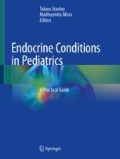Abstract
Hyperandrogenism, defined as elevated circulating C19 androgen (dehydroepiandrosterone [DHEA], dehydroepiandrosterone sulfate [DHEAS], androstenedione, and testosterone) concentrations, presents with a variety of clinical and biochemical characteristics. Typically, in females, hyperandrogenism is due to increased adrenal and/or ovarian C19 steroid androgen production. Hyperandrogenism is often associated with an underlying endocrine disorder. Common presenting features in adolescent girls include hirsutism, severe acne that is unresponsive to topical medications, and irregular menses. Evaluation includes a thorough history and physical exam followed by laboratory studies to assess for elevated circulating androgens. Suspicion for polycystic ovary syndrome, disorders of steroidogenesis, or an androgen-secreting tumor should prompt referral to pediatric endocrinology for evaluation and management. Topical or cosmetic treatments may benefit some patients with familial isolated hirsutism and acne, a diagnosis of exclusion. Poor response to these treatments should prompt further evaluation to assess for hyperandrogenism with a specialist.
Access this chapter
Tax calculation will be finalised at checkout
Purchases are for personal use only
References
Rege J, Turcu AF, Else T, Auchus RJ, Rainey WE. Steroid biomarkers in human adrenal disease. J Steroid Biochem Mol Biol. 2019;190:273–80.
Escobar-Morreale HF, Carmina E, Dewailly D, Gambineri A, Kelestimur F, Moghetti P, et al. Epidemiology, diagnosis and management of hirsutism: a consensus statement by the Androgen Excess and Polycystic Ovary Syndrome Society. Hum Reprod Update. 2012;18(2):146–70.
Rosenfield RL. Clinical practice. Hirsutism. N Engl J Med. 2005;353(24):2578–88.
Deplewski D, Rosenfield RL. Role of hormones in pilosebaceous unit development. Endocr Rev. 2000;21(4):363–92.
Azziz R, Sanchez LA, Knochenhauer ES, Moran C, Lazenby J, Stephens KC, et al. Androgen excess in women: experience with over 1000 consecutive patients. J Clin Endocrinol Metab. 2004;89(2):453–62.
Ferriman D, Gallwey JD. Clinical assessment of body hair growth in women. J Clin Endocrinol Metab. 1961;21:1440–7.
Hatch R, Rosenfield RL, Kim MH, Tredway D. Hirsutism: implications, etiology, and management. Am J Obstet Gynecol. 1981;140(7):815–30.
Yildiz BO, Bolour S, Woods K, Moore A, Azziz R. Visually scoring hirsutism. Hum Reprod Update. 2010;16(1):51–64.
Teede HJ, Misso ML, Costello MF, Dokras A, Laven J, Moran L, et al. Recommendations from the international evidence-based guideline for the assessment and management of polycystic ovary syndrome. Hum Reprod. 2018;33(9):1602–18.
Essah PA, Wickham EP 3rd, Nunley JR, Nestler JE. Dermatology of androgen-related disorders. Clin Dermatol. 2006;24(4):289–98.
Azziz R, Carmina E, Chen Z, Dunaif A, Laven JS, Legro RS, et al. Polycystic ovary syndrome. Nat Rev Dis Primers. 2016;2:16057.
Lizneva D, Gavrilova-Jordan L, Walker W, Azziz R. Androgen excess: investigations and management. Best Pract Res Clin Obstet Gynaecol. 2016;37:98–118.
Witchel SF, Oberfield SE, Pena AS. Polycystic ovary syndrome: pathophysiology, presentation, and treatment with emphasis on adolescent girls. J Endocr Soc. 2019;3(8):1545–73.
Witchel SF, Burghard AC, Tao RH, Oberfield SE. The diagnosis and treatment of PCOS in adolescents: an update. Curr Opin Pediatr. 2019;31(4):562–9.
Witchel SF. Congenital adrenal hyperplasia. J Pediatr Adolesc Gynecol. 2017;30(5):520–34.
Hannah-Shmouni F, Morissette R, Sinaii N, Elman M, Prezant TR, Chen W, et al. Revisiting the prevalence of nonclassic congenital adrenal hyperplasia in US Ashkenazi Jews and Caucasians. Genet Med. 2017;19(11):1276–9.
Arhan E, Cetinkaya E, Aycan Z, Aslan AT, Yucel H, Vidinlisan S. A very rare cause of virilization in childhood: ovarian Leydig cell tumor. J Pediatr Endocrinol Metab. 2008;21(2):181–3.
Lodish MB, Keil MF, Stratakis CA. Cushing’s syndrome in pediatrics: an update. Endocrinol Metab Clin N Am. 2018;47(2):451–62.
Baranowski ES, Arlt W, Idkowiak J. Monogenic disorders of adrenal steroidogenesis. Horm Res Paediatr. 2018;89(5):292–310.
White PC. Alterations of cortisol metabolism in human disorders. Horm Res Paediatr. 2018;89(5):320–30.
Phelan N, Williams EL, Cardamone S, Lee M, Creighton SM, Rumsby G, et al. Screening for mutations in 17beta-hydroxysteroid dehydrogenase and androgen receptor in women presenting with partially virilised 46,XY disorders of sex development. Eur J Endocrinol. 2015;172(6):745–51.
Screening and management of the hyperandrogenic adolescent: ACOG Committee Opinion, Number 789. Obstet Gynecol. 2019;134(4):e106–e14.
Armengaud JB, Charkaluk ML, Trivin C, Tardy V, Breart G, Brauner R, et al. Precocious pubarche: distinguishing late-onset congenital adrenal hyperplasia from premature adrenarche. J Clin Endocrinol Metab. 2009;94(8):2835–40.
Glintborg D, Altinok ML, Petersen KR, Ravn P. Total testosterone levels are often more than three times elevated in patients with androgen-secreting tumours. BMJ Case Rep. 2015;2015:bcr2014204797.
Azziz R, Carmina E, Sawaya ME. Idiopathic hirsutism. Endocr Rev. 2000;21(4):347–62.
Randall VA. Androgens and hair growth. Dermatol Ther. 2008;21(5):314–28.
Nguyen HL, Tollefson MM. Endocrine disorders and hormonal therapy for adolescent acne. Curr Opin Pediatr. 2017;29(4):455–65.
Author information
Authors and Affiliations
Corresponding author
Editor information
Editors and Affiliations
Rights and permissions
Copyright information
© 2021 Springer Nature Switzerland AG
About this chapter
Cite this chapter
March, C., Witchel, S. (2021). Acne, Hirsutism, and Other Signs of Increased Androgens. In: Stanley, T., Misra, M. (eds) Endocrine Conditions in Pediatrics. Springer, Cham. https://doi.org/10.1007/978-3-030-52215-5_14
Download citation
DOI: https://doi.org/10.1007/978-3-030-52215-5_14
Published:
Publisher Name: Springer, Cham
Print ISBN: 978-3-030-52214-8
Online ISBN: 978-3-030-52215-5
eBook Packages: MedicineMedicine (R0)

